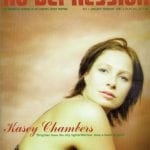Cowboy couture
This pattern of exchange between culture, performance and practicality repeats itself in each gallery, reflecting the great diversity of culture, utility and aesthetics of the American West. From the simpler forms of dress, we see how the more elegant types of clothing developed. For example, Mexican vaquero attire became a model from which American designers and tailors fashioned both cowhands and country music stars. These Mexican influences are never more evident than in the works on display by Nudie The Rodeo Tailor, whose credits include Elvis’ gold lame outfit, Porter Wagoner’s wagon wheel suit, and Gram Parsons’ rhinestoned reefer costume. Nudie’s greatest achievements, however, in terms of influencing the fashion of the American public, came from his designs for the singing cowboys such as Gene Autry and Roy Rogers.
While the displays are infinitely interesting on their own, as the visitor moves from one costume to the next, the accompanying narrative suggests but fails to articulate one subtle but imperative connection — the enormous and ironic role that minority cultures played in the development of this quintessentially American emblem. Though Anglo-American cowboy fashion and culture form the core of this exhibit, the influential elements of minority cultures are abundantly present.
This collection points to something more profound about the role of marginalized populations in the formation of American ethos and fashion. Obvious associations can be made between the flowery embroidery of the Mexican mariachi suits and the famous Nudie Suits. However, a deeper cultural exchange is suggested by the popular term for cowboy, buckaroo, which is an Anglicization of the Spanish word vaquero, translating directly as “cowboy.” Furthermore, Nudie himself was a Jewish immigrant from Russia, and his principal designer for more than fourteen years was Manuel Cuevas, from Mexico.
Today, Manuel is a pre-eminent Nashville designer for contemporary country musicians and Hollywood personalities alike. His influential designs date back to the mid-1950s, when television and movie cowboys had a sizable influence on popular culture.
“Western is not necessarily fringe, guns and saddles,” Manuel commented in a recent interview for the Country Music Hall of Fame’s Oral History Program. “We are not totally educated about the western culture. A lot of people want to put you in that western box, but I think it’s this whole American heritage. It’s from the settlers, from the Native Americans. All these things have been around. I mean, you can find them painted, carved in rocks that date thousands of years back. My idea was just to bring them out and do something with them, to fill them up with rhinestones and do the embroidery.”
For Manuel, playing a key role in defining the American identity was an unfathomable dream. He recalls that during his childhood years in Mexico, “I walked miles and miles to see the episodes of the Lone Ranger. And to come to the United States of America and to make the mask and the outfits for Clayton Moore, the new Lone Ranger, that’s just fantastic.”
A important predecessor to Nudie and Manuel was Nathan Turk, a Jewish immigrant from Poland. His early county & western designs set the stage for the new look that swept the country music industry in the late 1940s and early ’50s. His ornate, intricate patterns of flowers, common in the wardrobes of Rose Maddox and Annie Oakley, are easily traced to eastern European folk dress. Fringe, which is common in much of the singing cowboy costumes on display, is an obvious appropriation of a Native American tradition.
While Jewish immigrants, Mexican ranchers and Native Americans enjoyed little prestige, their contributions to the image, and no doubt the ethos, of the American cowboy were considerable. But despite this oversight, “How The West Was Worn” delivers. It presents the relationships among the fashion of the working rancher, Hollywood designers, country music performers and movie stars. It is colorful, fun and historically informative.
Most importantly, the exhibit begins to explain the legacy of western expansion as a physical endeavor and as a romantic artistic expression, both of which profoundly inform the American worldview and attitude. The exhibit is accompanied by a fabulously illustrated book of the same name, written by Holly George-Warren. Collectively, the temporary exhibits and the seven permanent galleries at the Autry Museum of Western Heritage offer an enriching and immensely entertaining excursion.




